-
ORIGINAL ARTICLE09-19-2022
Colorectal cancer mortality in women: trend analysis in Brazil and its regions and states
Revista Brasileira de Enfermagem. 2022;75(2):e20210751
Abstract
ORIGINAL ARTICLEColorectal cancer mortality in women: trend analysis in Brazil and its regions and states
Revista Brasileira de Enfermagem. 2022;75(2):e20210751
DOI 10.1590/0034-7167-2021-0751
Views0See moreABSTRACT
Objectives:
to analyze colorectal cancer mortality trends in women in Brazil and its regions and states.
Methods:
ecological, time-series study with trend analysis of deaths caused by colorectal cancer in women in Brazil and its regions and states between 2008 and 2019. Polynomial regression was used to treat the data.
Results:
48,225 deaths of women caused by colorectal cancer were examined. There was an increasing mortality trend in Brazilian women, with regional differences that resulted from socioeconomic, political, and cultural inequalities. The South Region stood out with the highest rate (7.32) in 2008, which increased to 8.65 in 2019, followed by the Southeast Region, whose rates were 6.72 and 9.05 in 2008 and 2019, respectively.
Conclusions:
colorectal cancer mortality increased, which indicates the need to expand public policies oriented toward screening and early diagnosis of colorectal cancer in women.
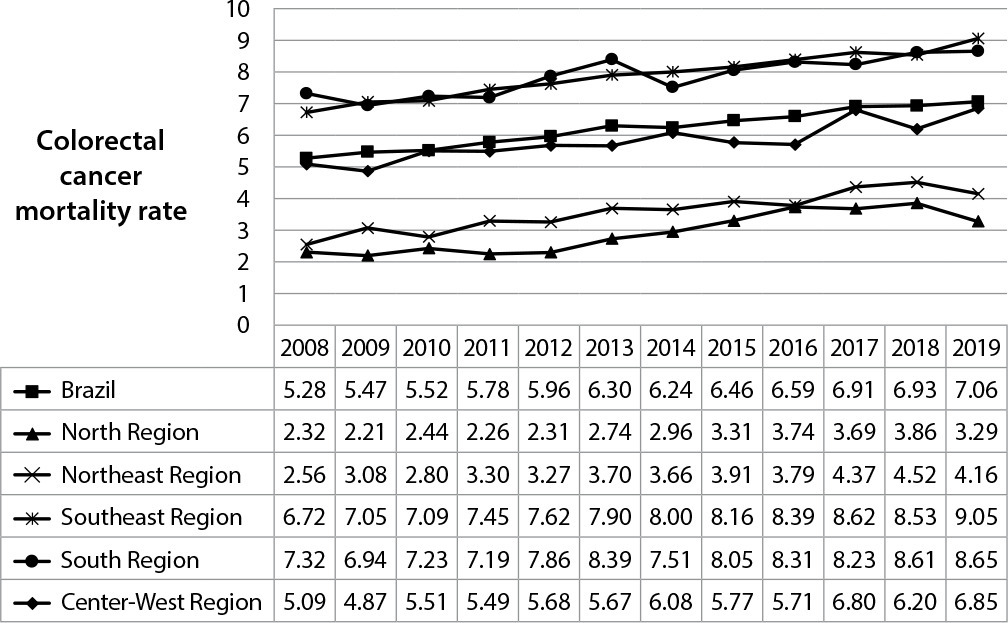
-
REVIEW09-19-2022
Authentic leadership in the educational system and in nursing education: an integrative review
Revista Brasileira de Enfermagem. 2022;75(1):e20220122
Abstract
REVIEWAuthentic leadership in the educational system and in nursing education: an integrative review
Revista Brasileira de Enfermagem. 2022;75(1):e20220122
DOI 10.1590/0034-7167-2022-0122
Views0See moreABSTRACT
Objectives:
to identify and analyze the knowledge produced in literature about authentic leadership in the educational system, as well as in nursing education.
Methods:
an integrative review, carried out in the Scopus, Web of Science, CINAHL, MEDLINE/PubMed, ERIC, LILACS databases. Articles that addressed authentic leadership in the educational system from a general perspective and within the nursing scope, as well as teaching practices of this leadership model, were eligible.
Results:
twenty-three articles met the inclusion criteria, most published in 2019, highlighting studies in the context of teaching, with a predominance in the nursing course and which were synthesized into three thematic categories.
Final Considerations:
it was found that the higher the levels of authentic leadership in the educational system, the higher the rates of other positive factors related to it, such as trust, involvement, academic optimism, responsibility, creativity, among others.
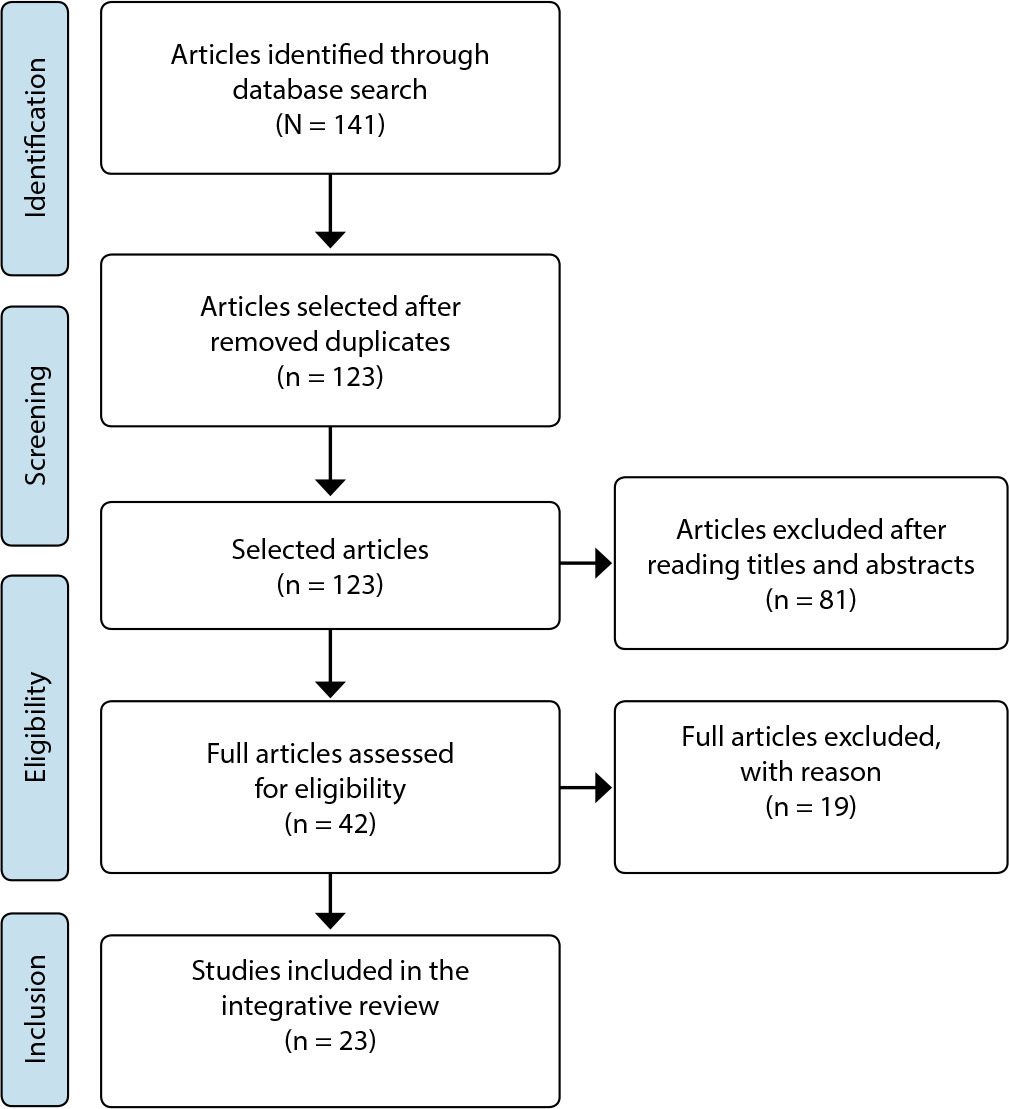
-
ORIGINAL ARTICLE09-19-2022
ICNP® nursing diagnoses for clinical practice in spinal cord injury rehabilitation
Revista Brasileira de Enfermagem. 2022;75(1):e20210670
Abstract
ORIGINAL ARTICLEICNP® nursing diagnoses for clinical practice in spinal cord injury rehabilitation
Revista Brasileira de Enfermagem. 2022;75(1):e20210670
DOI 10.1590/0034-7167-2021-0670
Views0See moreABSTRACT
Objectives:
to construct statements of nursing diagnoses for the clinical practice of rehabilitation of people with spinal cord injury using the International Classification for Nursing Practice (ICNP®) and Orem’s theory of self-care.
Methods:
methodological study developed in four steps: identification of relevant terms to clinical nursing practice in the rehabilitation of people with spinal cord injury; mapping of selected terms with ICNP® terms; construction of nursing diagnoses statements; mapping of statements constructed with pre-coordinated concepts of the ICNP®.
Results:
241 statements of nursing diagnoses were constructed and categorized according to the self-care requisites of the theory. The most prevalent statements were those related to universal requisites, followed by developmental requisites and health deviation requisites.
Conclusions:
the constructed nursing diagnoses reflect the complexity of phenomena evidenced in the clinical practice of rehabilitation, allowing a systematic and comprehensive care to the person with spinal cord injury.
-
ORIGINAL ARTICLE09-19-2022
Clustering the engagement of Brazilian nurses in political advocacy
Revista Brasileira de Enfermagem. 2022;75(1):e20210105
Abstract
ORIGINAL ARTICLEClustering the engagement of Brazilian nurses in political advocacy
Revista Brasileira de Enfermagem. 2022;75(1):e20210105
DOI 10.1590/0034-7167-2021-0105
Views0See moreABSTRACT
Objectives:
to analyze the level of nurses’ engagement in political advocacy by performing cluster analysis.
Methods:
observational study, with a quantitative approach. A total of 184 nurses working in primary, secondary, and tertiary care in a city in the south of Brazil completed the Policy Advocacy Engagement Scale. Data analysis consisted of descriptive statistics, cluster analysis, analysis of variance, and chi. The Institutional Review Board approved the study.
Results:
four differentiated clusters were found according to professional experience, level of healthcare complexity, and unit. The cluster analysis revealed that patient advocacy for community-based obtained the highest mean, indicating that political advocacy is effective in organizational environments and that professional qualification favors greater engagement in political advocacy.
Conclusions:
the results reveal that nurses play an active role in political advocacy, seeking to promote positive changes in health, especially those working in tertiary care, the nurse group that obtained the highest means.
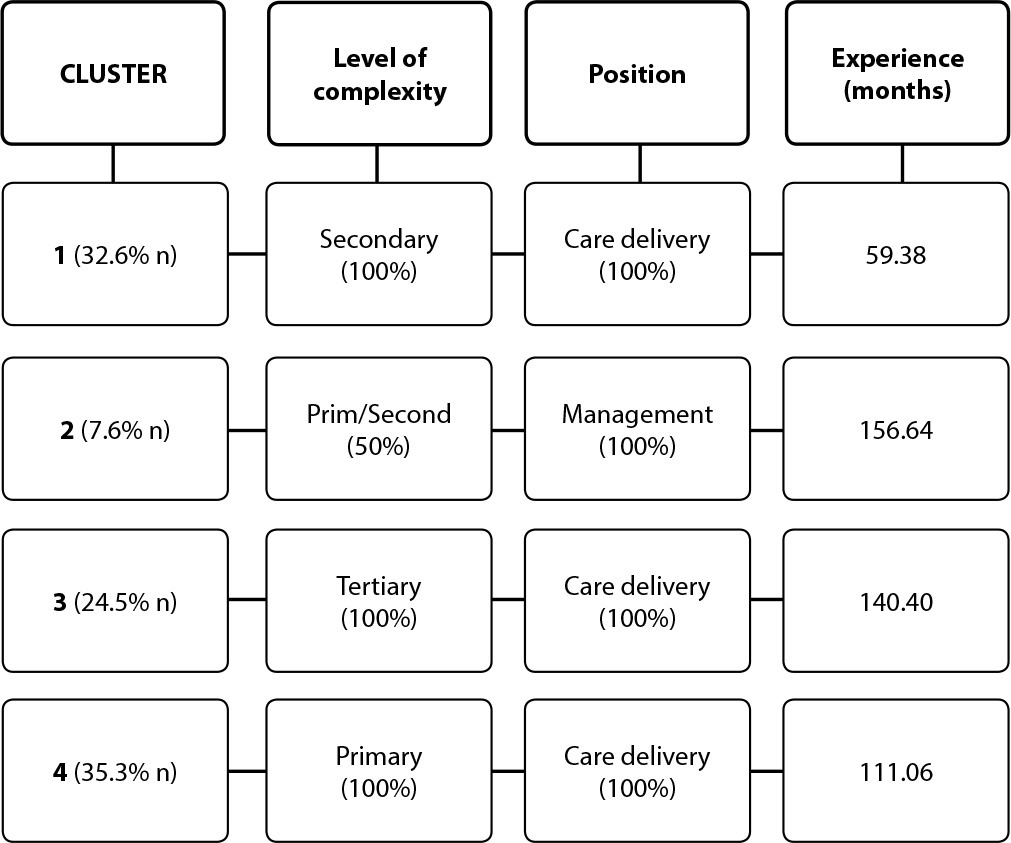
-
ORIGINAL ARTICLE09-19-2022
The experience of trans or transvestite women in accessing public health services
Revista Brasileira de Enfermagem. 2022;75:e20210713
Abstract
ORIGINAL ARTICLEThe experience of trans or transvestite women in accessing public health services
Revista Brasileira de Enfermagem. 2022;75:e20210713
DOI 10.1590/0034-7167-2021-0713
Views0See moreABSTRACT
Objective:
to understand the meanings of being a trans or transvestite woman in the care provided by Unified Health System health professionals.
Methods:
qualitative research, guided by Heidegger’s phenomenology, with 10 trans or transvestitewomen residing and using the Unified Health System in a municipality in Minas Gerais. Fieldwork was carried out by interviews.
Results:
trans or transvestitewomen reproduce the social patterns constructed and accepted by the female, with the search for hormonization being common, and, when it is difficult to obtain a prescription, they resort to self-medication. Social name use and acceptance by health professionals promote recognition. Trans or transvestitewomen experience prejudice on a daily basis, not only by professionals, but also because of the assumption of diagnoses by other users.
Final considerations:
transphobia promotes withdrawal from health services, due to fear, shame, knowledge about professionals’ unpreparedness, triggering illness, social exclusion and violence.
-
ORIGINAL ARTICLE09-19-2022
Neurobehavioral signals in preterm infants in body weight check: a quasi-experimental study
Revista Brasileira de Enfermagem. 2022;75:e20210584
Abstract
ORIGINAL ARTICLENeurobehavioral signals in preterm infants in body weight check: a quasi-experimental study
Revista Brasileira de Enfermagem. 2022;75:e20210584
DOI 10.1590/0034-7167-2021-0584
Views0See moreABSTRACT
Objective:
to describe and compare the frequency of neurobehavioral signs in preterm infants in traditional and humanized body weight check.
Methods:
a quantitative, quasi-experimental, cross-over study, carried out in a Neonatal Unit at a university hospital with a sample of 30 preterm newborns, randomly assigned and allocated in control group (traditional) and intervention group (humanized), with collection of general data, vital signs before and after procedures and footage.
Results:
there was a higher frequency of approach signs in humanized weight check compared to traditional check. Moreover, withdrawal signs were more frequent in traditional weight check compared to humanized check.
Conclusion:
in this regard, humanized body weight check provided greater benefits to preterm infants, making it necessary to foster discussions about humanization of care, so that this practice can be performed routinely in health units.
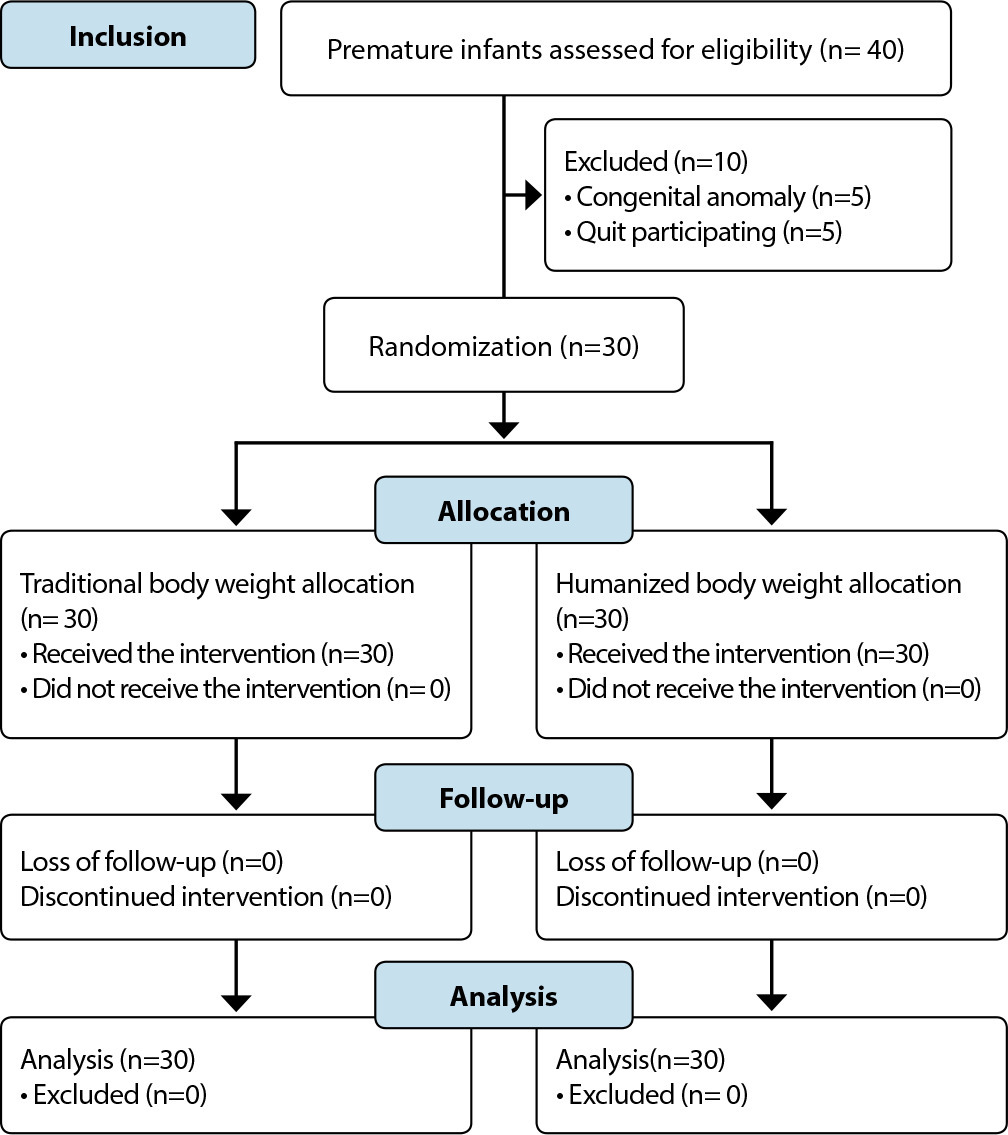
-
ORIGINAL ARTICLE09-19-2022
Implications of health conditions on rural soybean workers’ quality of life
Revista Brasileira de Enfermagem. 2022;75:e20210983
Abstract
ORIGINAL ARTICLEImplications of health conditions on rural soybean workers’ quality of life
Revista Brasileira de Enfermagem. 2022;75:e20210983
DOI 10.1590/0034-7167-2021-0983
Views0See moreABSTRACT
Objective:
to analyze the implications of health conditions on rural workers’ quality of life in the context of soybean production.
Method:
a cross-sectional study, with an intentional sample of 299 male rural workers. Data collection took place between October and December 2019. The following instruments were used: World Health Organization Quality Life-bref; Rural Workers’ Living & Health Conditions questionnaire; International Physical Activity Questionnaire; Cut down, Annoyed, Guilty, and Eye-opener. They were analyzed via descriptive and inferential statistics, using bivariate (Mann-Whitney; Kruskal-Wallis) and multivariate tests (generalized additive models for location, scale and shape).
Results:
the presence of a diagnosis of morbidity, alcohol dependence, occupational accidents and absenteeism implied a decrease in workers’ quality of life scores.
Conclusion:
the existence of unfavorable health conditions has a negative impact on rural soybean workers’ quality of life.
-
ORIGINAL ARTICLE09-19-2022
Terminological relationships between nursing diagnoses for children with kidney diseases
Revista Brasileira de Enfermagem. 2022;75:e20210841
Abstract
ORIGINAL ARTICLETerminological relationships between nursing diagnoses for children with kidney diseases
Revista Brasileira de Enfermagem. 2022;75:e20210841
DOI 10.1590/0034-7167-2021-0841
Views0See moreABSTRACT
Objective:
To identify the relationships between the statements of nursing diagnoses for children with kidney diseases prepared according to the International Classification for Nursing Practice (ICNP®) with the diagnoses of NANDA International (NANDA-I).
Methods:
Methodological study operationalized by the steps: 1) Survey of clinical findings through interviews and physical examination with children; 2) Elaboration of nursing diagnoses through Gordon’s clinical judgment; 3) Cross-mapping of diagnostic statements between the NANDA-I and ICNP® classification systems; 4) Content validation using the Delphi technique, in two rounds, with specialist nurses.
Results:
90 children participated. A total of 151 diagnoses were made, of which 66.3% (n=100) used ICNP® terminology and 33.7% (n=51) used NANDA-I; 55 diagnoses showed equivalence of meanings.
Conclusions:
Cross-mapping of diagnoses was achieved starting from the reality of children, using clinical reasoning and validation by specialist nurses.
-
REVIEW12-21-2020
Lean Six Sigma methodology application in health care settings: an integrative review
Revista Brasileira de Enfermagem. 2020;73:e20190861
Abstract
REVIEWLean Six Sigma methodology application in health care settings: an integrative review
Revista Brasileira de Enfermagem. 2020;73:e20190861
DOI 10.1590/0034-7167-2019-0861
Views0See moreABSTRACT
Objective:
to analyze the scientific production on the results of Lean Six Sigma methodology in health care institutions.
Methods:
an integrative literature review, with the following question: what are the results in health institutions using Lean Six Sigma and Six Sigma methodology? The search was carried out at MEDLINE, LILACS, BDENF, CINAHL, Web of Science, and Scopus, with no time frame.
Results:
thirty-four articles were included, published between 2005 and 2019, of which 52.9% came from the United States of America. The most commonly found improvements were in hospital institutions and from the perspective of customers and internal processes.
Conclusion:
using Lean Six Sigma methodology proved to be effective in the different health care settings, evidencing a gap in its application regarding people engagement and training.
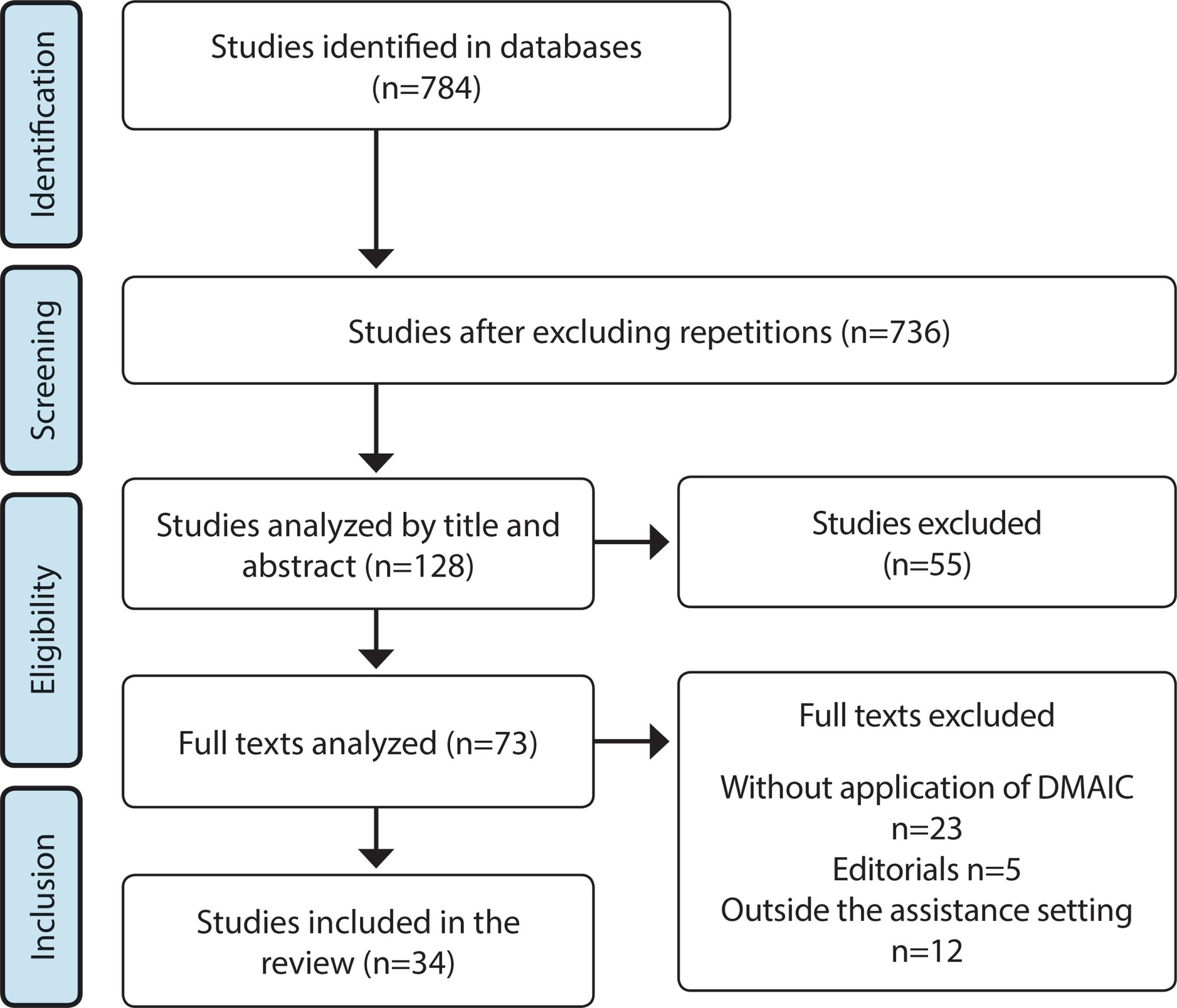
-
REFLECTION06-29-2020
Recommendations in covid-19 times: a view for home care
Revista Brasileira de Enfermagem. 2020;73:e20200310
Abstract
REFLECTIONRecommendations in covid-19 times: a view for home care
Revista Brasileira de Enfermagem. 2020;73:e20200310
DOI 10.1590/0034-7167-2020-0310
Views0See moreABSTRACT
Objective:
To suggest recommendations for the practice of Home Nursing in the context of COVID-19.
Method:
Reflective study, originated from readings associated with the theme, available in current guidelines from the Pan American Health Organization, World Health Organization and the Ministry of Health.
Results:
Recommendations were developed from current scientific evidence for prevention of infections, control of epidemics and pandemics in the Brazilian home scenario.
Final considerations:
the reflections achieved contribute to guiding actions for better assistance to the patient, family caregivers and the community in the perspective of safe home care with COVID-19, and it is characterized as an introductory discussion on the theme, encouraging new studies to be carried out from the unfolding of the current scenario.
-
ORIGINAL ARTICLE06-16-2021
Patient participation in care safety: Primary Health Care professionals’ perception
Revista Brasileira de Enfermagem. 2021;74(2):e20200773
Abstract
ORIGINAL ARTICLEPatient participation in care safety: Primary Health Care professionals’ perception
Revista Brasileira de Enfermagem. 2021;74(2):e20200773
DOI 10.1590/0034-7167-2020-0773
Views0See moreABSTRACT
Objectives:
to analyze health professionals’ perception about the meaning and practice of patient involvement in care safety in Primary Health Care.
Methods:
this is an exploratory, qualitative study, developed with 22 professionals in the Federal District, Brazil. A semi-structured interview was conducted between October and November/2018. Content analysis was carried out according to Bardin.
Results:
nurses, physicians, dentists, among others, participated. The following categories emerged: Meaning of patient involvement in care safety; Factors intervening in patient involvement in care safety; Strategies for patient involvement in care safety; Qualification for patient involvement in care safety.
Final Considerations:
the meaning of patient involvement for care safety was associated with co-responsibility and patient-centered care. Professionals’ practice revealed intervening factors and the use of involvement strategies. A gap was identified in training on patient involvement in care safety.
-
REVIEW03-30-2020
Nursing care in mental health based on the TIDAL MODEL: an integrative review
Revista Brasileira de Enfermagem. 2020;73(2):e20180177
Abstract
REVIEWNursing care in mental health based on the TIDAL MODEL: an integrative review
Revista Brasileira de Enfermagem. 2020;73(2):e20180177
DOI 10.1590/0034-7167-2018-0177
Views0See moreABSTRACT
Objectives:
to identify the applicability of the Phil Barker’s Tidal Model in mental health nursing care.
Methods:
an integrative literature review carried out by LILACS, MEDLINE, Scopus and Web of Science. Data were collected from December 2017 to March 2018. After selecting the studies, the sample totaled 24 articles.
Results:
the articles are in English (91.7%), were published in nursing journals (87.5%), are reflective and/or theoretical (50%) and have level of evidence VII (79.2%). The model brings contributions to nursing science, enabling person-centered care, with an emphasis on interdisciplinary work, nurses’ protagonism and the empowerment of subjects in mental suffering.
Final considerations:
the use of the Tidal Model enables changes in nurses practice working in the context of mental health. Its application by nurses who work in mental health services in Brazil is recommended.

-
ORIGINAL ARTICLE12-05-2019
Perception of body image and nutritional status in adolescents of public schools
Revista Brasileira de Enfermagem. 2019;72:229-235
Abstract
ORIGINAL ARTICLEPerception of body image and nutritional status in adolescents of public schools
Revista Brasileira de Enfermagem. 2019;72:229-235
DOI 10.1590/0034-7167-2018-0644
Views0See moreABSTRACT
Objective:
To assess body image dissatisfaction among adolescents from Northern Minas Gerais.
Method:
This is a cross-sectional study with adolescents of both sexes, enrolled in the sixth to ninth year in the municipal public education network. A questionnaire was used, composed of sociodemographic and body image variables, which was obtained through a scale of silhouette figures. The anthropometric measurements of weight and height were performed to estimate body mass index. The correlation between the classification of the body mass index and the body image of adolescents was estimated through weighted Kappa.
Results:
A total of 535 adolescents participated, and 24.5% had different classifications between the real and ideal body image. The Kappa index for the classification of body image was 0.51, 0.58 and 0.32 for the total of adolescents, girls and boys, respectively.
Conclusion:
Public school adolescents are dissatisfied with their self-body image.
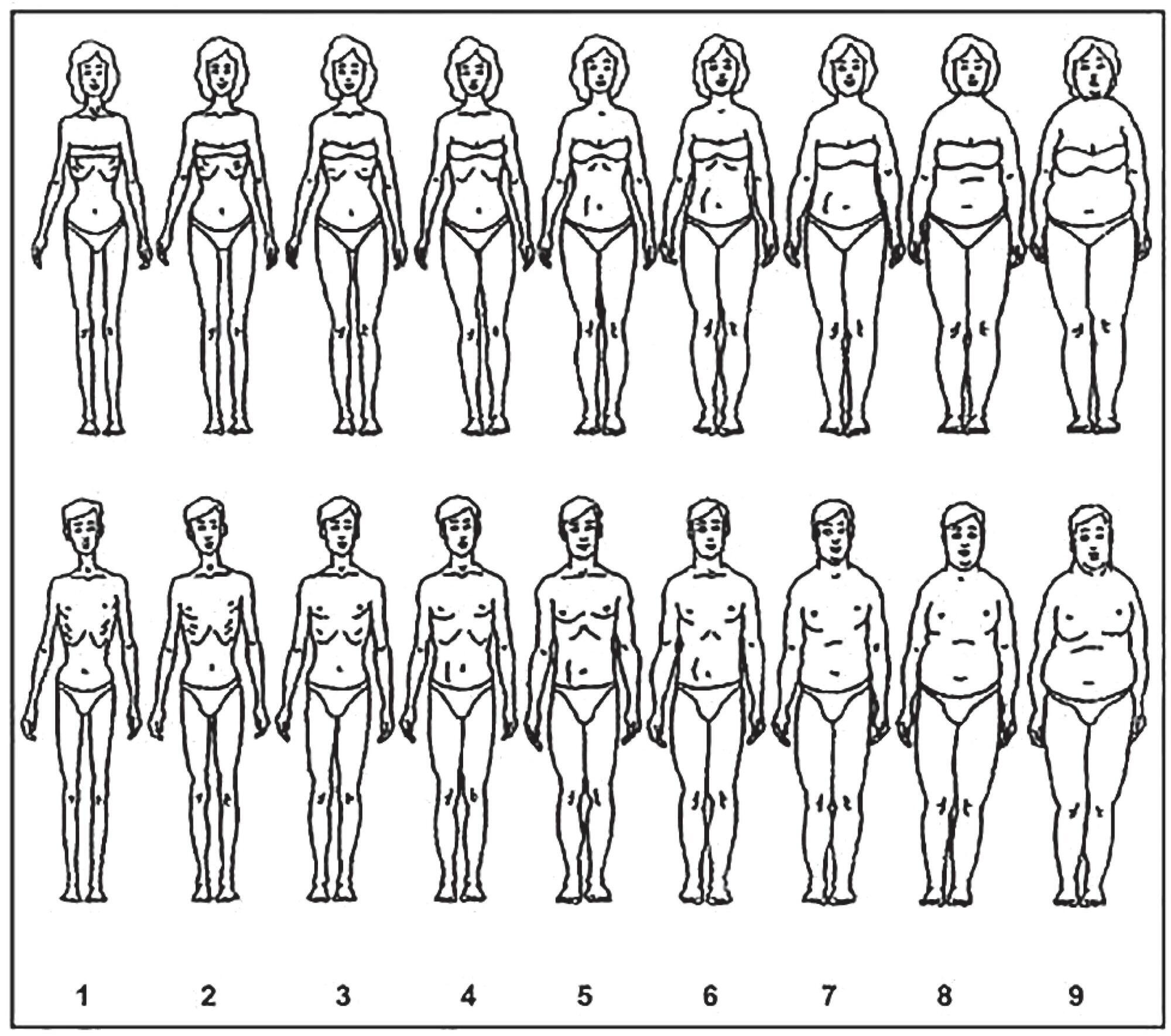
-
04-14-2021
Child behavior during the social distancing in the COVID-19 pandemic
Revista Brasileira de Enfermagem. 2021;74:e20200762
Abstract
Child behavior during the social distancing in the COVID-19 pandemic
Revista Brasileira de Enfermagem. 2021;74:e20200762
DOI 10.1590/0034-7167-2020-0762
Views0See moreABSTRACT
Objective:
To describe the daily activities performed by children from 6 to 12 years of age incomplete and analyze children’s behavior during social distancing in the face of the COVID-19 pandemic.
Methods:
Cross-sectional study with children in a learning stage living in Brazil. The data were collected via online form. Fisher’s exact test was applied to analyze the association of categorical variables with child behavior; when significant, it was used the odds ratio. It was considered results considered statistically significant those presenting values of p < 0.05.
Results:
Data from 530 children were analyzed: 50.3% female, 71.3% from the Southeast Region, 73% in fulltime social distancing, 52% presented anxiety, which was significantly associated with changes in sleep and appetite.
Conclusion:
The results indicate the need for parents/caretakers to stimulate moments for the child to express themselves, not minimizing their feelings and providing emotional support to mitigate the negative impact of these feelings on the child’s mental and physical health.
-
04-14-2021
Emotional labor of nurses in the front line against the COVID-19 pandemic
Revista Brasileira de Enfermagem. 2021;74:e20200660
Abstract
Emotional labor of nurses in the front line against the COVID-19 pandemic
Revista Brasileira de Enfermagem. 2021;74:e20200660
DOI 10.1590/0034-7167-2020-0660
Views1See moreABSTRACT
Objective:
To analyze nurses’ experiences in the front line of the fight against the COVID-19 pandemic regarding the performance of emotional labor (EL), aiming at its characterization and identification of support strategies and development opportunities of nurses and practices.
Methods:
Qualitative, descriptive, and exploratory study, with content analysis of eleven written narratives and reports from a focus group composed of nurses with experience in caring for patients with COVID-19 from different Hospital Centers in Lisbon, Portugal.
Results:
Five themes were extracted: 1) Challenges experienced by nurses in the frontline; 2) Emotions experienced by nurses in service care; 3) Emotional responses of nurses and patients: impact on care; 4) EL of nurses in the patient care process; 5) Opportunities for development in the face of the emotional challenge required of nurses in combating COVID-19.
Final considerations:
The nurses demonstrated the ability to transform this profoundly emotional experience positively.
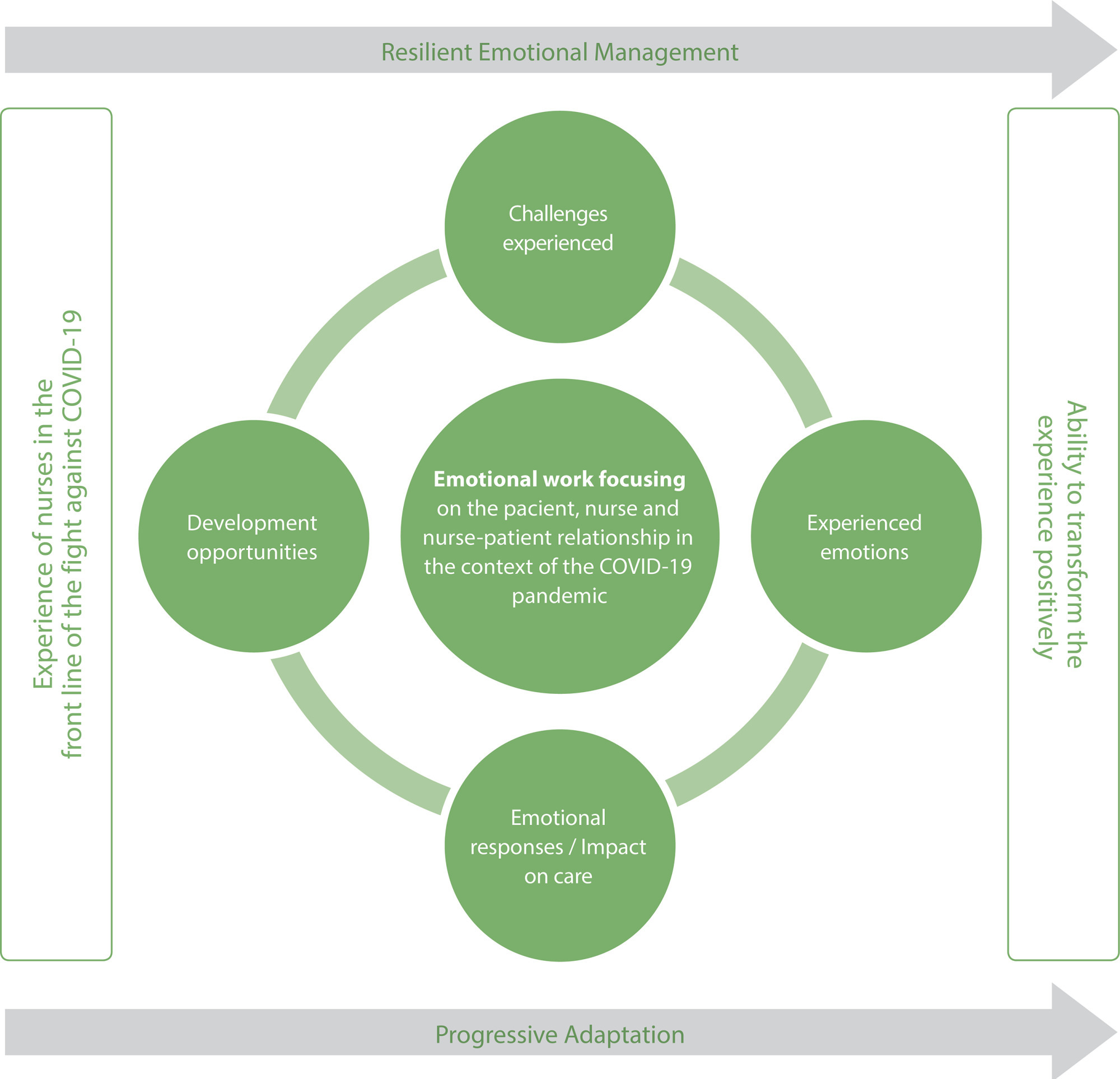
-
ORIGINAL ARTICLE10-19-2020
Factors associated with suicide risk among nurses and physicians: a cross-section study
Revista Brasileira de Enfermagem. 2020;73:e20200352
Abstract
ORIGINAL ARTICLEFactors associated with suicide risk among nurses and physicians: a cross-section study
Revista Brasileira de Enfermagem. 2020;73:e20200352
DOI 10.1590/0034-7167-2020-0352
Views1See moreABSTRACT
Objective:
to estimate the prevalence and factors associated with suicide risk among nurses and physicians.
Method:
a cross-sectional study carried out at a university hospital with 216 health professionals, who answered a socio-demographic-labor questionnaire, the Mini International Neuropsychiatric Interview (MINI) for assessing suicide risk, and the Depression, Anxiety and Stress Scale (DASS 21). The Poisson Regression Model was used for multiple analysis.
Results:
it was identified that variables such as not having a partner, history of attempted suicide, stress and depression symptoms were statistically associated with suicide risk. The prevalence of lifelong suicide attempts among nurses was 9.41%, and among physicians, 2.29%.
Conclusion:
the findings of this investigation enable the understanding of suicidal behavior among hospital nurses and physicians, in addition to enabling the development of prevention strategies in order to reduce suicide risk prevalence in this population group.
Search
Search in:
Nuvem de Tags
Adolescente (85) Atenção Primária à Saúde (239) COVID-19 (91) Criança (91) Cuidados de Enfermagem (269) Educação em Enfermagem (151) Educação em Saúde (139) Enfermagem (930) Enfermagem Pediátrica (86) Estudantes de Enfermagem (77) Estudos de Validação (131) Família (87) Idoso (208) Promoção da Saúde (99) Qualidade de Vida (104) Saúde do Trabalhador (86) Saúde Mental (145) Saúde Pública (82) Segurança do Paciente (150) Tecnologia Educacional (100)



